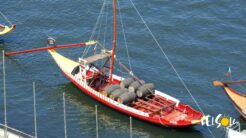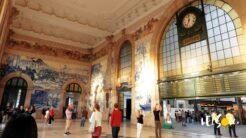When going to Porto, many people wonder which places in Porto are the ones most worth seeing. Well, we decided to compile a list just for them. What to see in Porto?
The Clérigos Church and Tower (Igreja e Torre dos Clérigos)
The Clerigos Church, alongside its equally famed brother, the Clerigos Tower (which also serves as a viewpoint) are the two objects which, alongside the Ponte Dom Luis I, can be considered the symbols of Porto. The church was established in 1732-50, while the tower came to be slightly later, in 1754-63. The tower is 75,6 metre tall. The church complex also consists of the Casa da Irmandade house. The main architect of this project was Nicolau Nasoni and this building is regarded to be his biggest achievement. A visit to the museum alongside the tower costs 5 EUR. It’s also possible to visit the tower at night, for the same price.
Ponte Dom Luis I (Dom Luis I Bridge)
Alongside the church and its tower, the Luis I Bridge is the main symbol of the city. The unusual construction of the Luis bridge connects the two riverbanks of Douro. The reason why we refer to it as ‘unusual’ is because the it’s actually a two-storey bridge. The lower storey is assigned to cars, while the upper serves as a viewpoint and a deck to walk on (it’s also connected to the city’s metro system). The upper storey got finished in 1886, on the 31st of october. The bridge is 385,25 m long and 44,6 m tall. We’ve dedicated one of our previous articles to the Dom Luis Bridge.
Monastery of Serra do Pilar
Near the bridge in Vila Nova de Gaia, there is a 1672’ monastery, built in a renaissance style, which is also one of the most famous viewpoints in Porto. One of the main traits of this place is its famed tower, at 35 metres of height. Thanks to the monastery’s location, it’s one of the constructions that are best visible from Porto. There’s also the a fairly distinct Serra do Pilar church, which gains its uniqueness through its oval shape.
Porto-São Bento station
The Porto-São Bento train station was put into service in 1916. Even if you’ve never used a train to get to Porto, we’d still say that the station is one of the must-see places in Porto. It’s not about trains, it’s not even that the station is all that beautiful of a building. It’s all about the azulejo mosaics inside of it. There are various scenes from the history of the country, made in 1905 – 1916, with the use of 20 thousand painted azulejo tiles. You can read about the best azulejo in Porto here.
Porto Cathedral (of the Assumption of Our Lady)
This Roman Catholic cathedral in Porto is one of the best examples of the Romanesque architecture in the city. The cathedral entered the works in 1110, while it reached its final form in 1737, in a baroque style. The cathedral, with its two characteristic towers, served as a defensive building. Inside, our attention can be grabbed by the renaissance staircase, the silver altar or the Joao Gordo tomb. The church’s open from 9:00 to 19:00.
Casa de Serralves and the Serralves Park
Time for a less famous place, the Serralves Park. Its 18 hectares of space are separated into various sections and its history dates back to the 30s of the 20th century. There are over 200 types of trees, flowers and bushes all situated in nicely kept gardens (there are a few wilder areas here and there). There are a few tourist trails, which vary mostly in length.
Palácio da Bolsa
This antique, neoclassical palace, funded by the city’s Commercial Association, is one of the Porto monuments which have found themselves on the UNESCO World Heritage Site list. The building process of the facility, designed by Joaquim da Costa Lima Junior, lasted over 30 years (1848-1880). The interiors were properly finished only after additional 30 years have passed, but they, alongside the courtyard, remain breathtaking. Visiting the palace costs 10 EUR, but it’s certainly worth the price.
The Church of Saint Francis
The greatest example of the gothic architecture style in Porto is the Saint Francis Church. The building, which was to be a part of the Franciscan monastery, entered the works in 1383. It lasted for quite a while, to be finally finished in 1425. During the Siege of Porto period in 1832, a portion of the buildings got destroyed, and in their place, the Palacio da Bolsa was erected.
Lello Bookstore
The Livraria Lello & Irmão in Porto is one of the oldest bookstores in the country. It has been operating non-stop since 1906, and it attracts tourists with its incredible, charming interior and its well known red stairs. The store’s appeal is not just aesthetical though, but also thanks to J.K. Rowling, who said that she’d visit the Porto often, when she needed inspiration when writing Harry Potter. The Lello Bookstore makes its way to our unusual tourist attraction list in Porto.
Igreja do Carmo – the Carmelitas Church
Igreja do Carmo is a temple built in 1756-1768, and it’s a church adjacent to the Carmelitas Church, built in 1616-1628. Both these buildings create a unique church complex, regarded as the Portugal’s national treasure. For tourists, which are not too big a fan of wandering aimlessly around old temples, there’s also the incredible azulejo mosaic on the church’s elevation, one of the most beautiful ones in all of Porto.
The Gardens of the Crystal Palace in Porto
The Crystal Palace from the 1865 was one of the biggest attractions in Porto, but unfortunately it’s gone. All that’s left is a sports hall, a fairly mediocre one at that. Thankfully, not all hope is lost, as one remainder of the palace’s past glory is the garden section, designed by Emile David. The gardens offer a beautiful view of Porto, an antique shrine of Carlos Alberto de Sardenya. It’s one of the most romantic places in Porto, beloved by both the locals and the tourists. The park’s open from 10:00 to 18:00. Apart from the beautiful views, there are also various birds to admire.
Botanic Garden in Porto
There’s plenty of gardens in Porto, although this one is especially worth visiting. The Botanic Garden in Porto is measured at 4 hectares, with its history dating back to the 19th century. The property was originally confiscated in 1949, only to be changed into a garden in 1951, which we can admire today. There’s the Jean Pierre Salabert and Joao Henrique residence, greenhouses, two ponds and an arboretum to see. The entry costs merely 5 EUR.
Douro river outlet in Porto
Although the Douro river, flowing through Spain and Portugal, is not incredibly impressive sizewise, it’s still incredibly famous. With 895 km of length, the river connects with the Atlantic Ocean in Porto. Perhaps for the locals it’s nothing too special, but for some of us, landrats, there aren’t too many opportunities to stare at the ocean.






